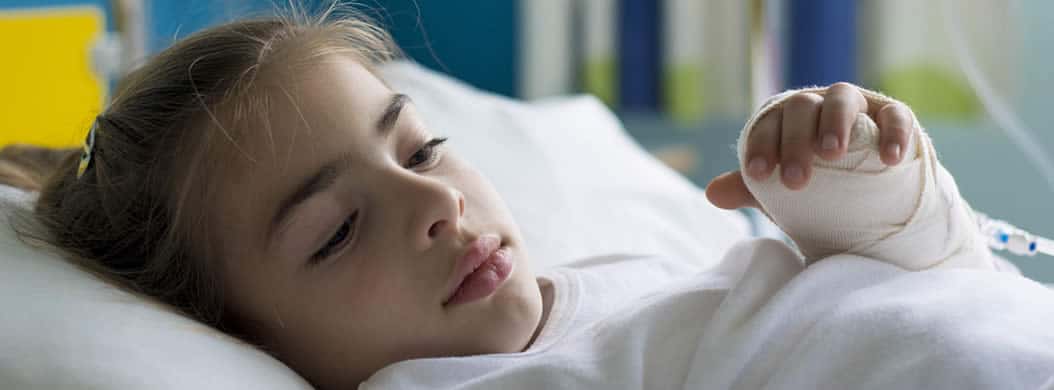

Limb reconstruction for pediatric patients may be performed to correct severe trauma or a congenital or developmental condition in which amputation is strongly considered. Fortunately, there are other options for many patients in these situations through the use of microvascular limb reconstruction, which uses tissue from other areas of the body to save and reconstruct the affected limb through a number of different techniques. Dr. Trussler has specialized training and experience in limb reconstruction to help patients of all ages salvage severely damaged limbs.
What Are My Pediatric Limb Reconstruction Options?
Microvascular limb reconstruction can be performed to correct a wide range of conditions, including:
- Congenital birth defects
- Traumatic injuries
- Developmental issues (such as bowlegs or knock-knees)
- Malignant tumors
Reconstruction is often performed after amputation or extensive surgical treatment performed to correct one of the conditions mentioned above. Dr. Trussler uses the latest and most advanced microsurgical techniques available to help restore function and appearance to affected limbs.
Considerations
Microvascular limb reconstruction can be performed on many patients with serious limb conditions, including children of nearly any age, but it is not appropriate in all cases. Dr. Trussler will perform a comprehensive evaluation to determine whether or not this type of treatment is right for the patient’s individual condition.
Expectations
It is important for patients to realize that microvascular limb reconstruction is often a long and multi-procedural process that will not completely restore an affected limb back to normal. Patients must maintain realistic expectations and be committed to a lengthy recovery process in order to receive the most successful results from these procedures.
Treatment
The type of procedure performed depends on each patient’s individual condition. Dr. Trussler may utilize one or more of the following techniques in order to salvage or reconstruct a limb:
- Skin grafting
- Local or musculocutaneous flaps
- Soft tissue covers
- Tendon transfer
- Callus distraction
These procedures are performed in a hospital setting under general anesthesia, and usually, require a lengthy recovery period as the patient regains use of the affected limb and learns to cope with their treatment.
Is Pediatric Limb Reconstruction a Painful Procedure?
No. Your child will receive general anesthesia for their surgical reconstruction. General anesthesia is delivered continuously until the end of the procedure and is monitored by a board-certified anesthesiologist. Under general anesthesia, patients are "asleep." This is because the sedative used to anesthetize them disrupts the nerve nuclei that are involved in the sleep/wake cycle. General anesthesia also activates certain neurons in the brain, producing a strong analgesic effect, so you can trust that your child will be pain-free during their necessary procedure. After surgery, appropriate prescription pain relievers should be taken as directed to manage post-operative comfort.
Are There Any Risks Involved with Pediatric Limb Reconstruction?
Limb reconstruction is complex and carries inherent risks. Dr. Trussler will sit with you to discuss those that pertain to your child. We understand that the need for reconstructive surgery can be extremely stress-inducing. Information is our greatest weapon against this. The main risks associated with any surgery include problems with anesthesia, infection, bleeding, nerve damage, and poor wound healing. There is a risk of prolonged discomfort, stiffness, or changes in sensation in the limb. If there are additional risks associated with your child's case, the doctor will bring them up during your consultation and answer any questions you have.
What Activities Should be Avoided After the Procedure?
After limb reconstruction surgery, your child will follow specific care instructions that may include avoiding certain activities for a short time. Which activities are restricted will depend on the type of repair they receive. You will be given detailed instructions regarding activity limitations and their duration. At each post-op visit to check the progress of recovery, the doctor may ease restrictions somewhat based on how well your child is healing.
Will Pediatric Limb Reconstruction Leave Noticeable Scarring?
Scarring may be noticeable after limb reconstruction. As much as possible, Dr. Trussler makes incisions in areas where the resulting scars will be hidden or very discreet. Children's bodies are still in collagen-producing mode, so wound healing tends to be better than we see in adult patients. That said, once the incisions have healed, you may talk to the doctor about treating scars with silicone sheets or other therapies.
Will Physical Therapy Help After Pediatric Limb Reconstruction?
Play is integral to your child's learning and overall well-being. We understand this, and we know that reconstructive surgery will affect their mobility for a short time. A formal physical therapy program will help your child get back to their important work of playing and being active doing the activities they love! Your physical therapist will work to restore your child's activity level to what it was before surgery. Sessions will help achieve this by increasing strength and mobility, and also supporting the child in learning how to manage their injury during their recovery period.
Limb Reconstruction Recovery
As with any surgical procedure, patients will likely experience swelling, bruising and pain after limb reconstruction surgery. The treated area will be covered with a dressing or bandage, and a splint or brace may be used as well to keep the area immobilized during healing. Dr. Trussler can provide patients with pain medication as needed during recovery.
Patients will likely need to undergo physical therapy after surgery in order to restore function to the affected limb, including strengthening the muscles and flexibility. Dr. Trussler will provide patients with specific instructions based on their individual treatment to promote proper healing and a quick return to previous activity levels.

Whether you have a question or would like to set up a consultation, Dr. Trussler and his staff are here to help. Please fill out our contact form, or call our office at 512-450-1077 to schedule an appointment. Start your journey to not only looking but feeling better today!
